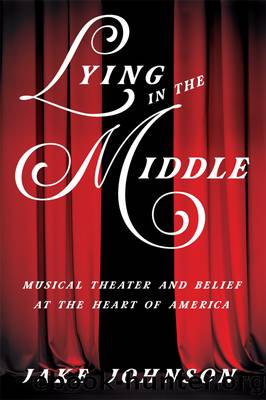Lying in the Middle by Jake Johnson

Author:Jake Johnson
Language: eng
Format: epub
ISBN: 9780252052859
Publisher: University of Illinois Press
Published: 2021-08-15T00:00:00+00:00
Example 5.1: The final bars of âOklahomaâ with âBoomer Soonerâ interpolation, as played by the University of Oklahoma Pride of Oklahoma Marching Band. âOklahoma,â music by Richard Rodgers. âBoomer Sooner,â lyrics by Arthur M. Alden, music taken from Yale Universityâs âBoola Boolaâ and attributed to Allan M. Hirsch. Courtesy of Brian Britt.
One year we mashed together the song âTiny Bubblesâ with Lerner and Loeweâs âThe Night They Invented Champagneâ from Gigi. With a nod toward Hawaiian performer Don Hoâs original version, âTiny Bubblesâ was performed as a solo accompanied by ukulele, soft-shoe dancing, and a bubble machineâall reinforcing the connection between âtiny bubbles in the wineâ and the sparkling froth of champagne. Aside from the more obvious textual connection the two songs share, the mashup was crafted to make a clever statement regarding aging stereotypes. The film-turned-musical Gigi is mostly known for the humorous song âI Remember It Well,â which entails an older couple reminiscing about their early courtship, yet neither one can quite remember well enough to get the facts straightened out. Instead, we chose âThe Night They Invented Champagneâ as a companion to âTiny Bubblesâ in order to frustrate that assumption of decline and pump more bubbly energy into the beginning of the show.
A more poignant moment later in the evening was a mashup of âIt Was a Very Good Year,â famous for Frank Sinatraâs 1965 melancholic performance, with âLet the Sunshine Inâ from the musical Hair.46 The combination of the two seemed opportune. âLet the Sunshine Inâ is already known as a mashup of sorts. Its attachment to the song âAquariusâ from Hair, by the 5th Dimension, made it to the top of Billboardâs listing of pop singles in 1969 and has led more than a few listeners to hear âLet the Sunshine Inâ as the ending to the preceding song rather than a separate number altogether. Likewise, the songâs six bars of interminable oscillation between major and minor conjures feelings of melancholy or bittersweet, its resisting of easy modal description a comfortable likeness to the Senior Follies penchant for defying convention, for easing into the Middle. I restructured the Sinatra-associated tune to allow time for several of the more prominent cast members to sing their respective ages and harmonized it to better fit the upbeat sixties groove. âIt Was a Very Good Yearâ originally makes a case for happiness at the ages of seventeen, twenty-one, and thirty-five. Our cast sang a canon of more mature age admissions during the mashup, starting with âwhen I was seventeen, twenty-one, thirty-fiveâ and so on, and ending with a resounding and applauded âeighty-sixââthe age of our oldest cast member.
Finally, we slightly tweaked the last verse to better fit the ideology of the Senior Follies. Originally, Sinatra croons about the shortened days of old ageââthe autumn of my yearsââand looks backward as vindication of a life well lived, singing that, back then, âit was a very good year.â In our version, the cast pulled out miniature glow sticks, identical to those distributed to the audience upon admission, and pronounced âit is a very good year.
Download
This site does not store any files on its server. We only index and link to content provided by other sites. Please contact the content providers to delete copyright contents if any and email us, we'll remove relevant links or contents immediately.
The Goal (Off-Campus #4) by Elle Kennedy(13544)
Kathy Andrews Collection by Kathy Andrews(11738)
Diary of a Player by Brad Paisley(7488)
What Does This Button Do? by Bruce Dickinson(6138)
Assassin’s Fate by Robin Hobb(6134)
Big Little Lies by Liane Moriarty(5711)
Altered Sensations by David Pantalony(5048)
Pale Blue Dot by Carl Sagan(4917)
Sticky Fingers by Joe Hagan(4106)
The Death of the Heart by Elizabeth Bowen(3555)
The Heroin Diaries by Nikki Sixx(3497)
Beneath These Shadows by Meghan March(3268)
Confessions of a Video Vixen by Karrine Steffans(3247)
How Music Works by David Byrne(3191)
The Help by Kathryn Stockett(3088)
Jam by Jam (epub)(3028)
Harry Potter 4 - Harry Potter and The Goblet of Fire by J.K.Rowling(2996)
Strange Fascination: David Bowie: The Definitive Story by David Buckley(2805)
Petty: The Biography by Warren Zanes(2698)
